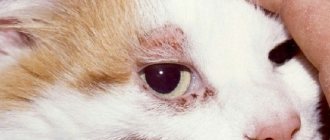As you know, the hearing organs for cats are as important as the sense of smell, sight, and touch.
Unfortunately, even pets that do not leave the apartment are not immune from otitis media. It is necessary to treat otitis in cats at an early stage, since the process from the external auditory canal, in the absence of help, quickly moves to the middle and then to the inner ear. Cat owners, when faced with a similar problem, often ignore the disease or do not know how it can be cured. First of all, it is necessary to find out the cause of the inflammatory phenomenon, but this cannot be done at home, so you should not delay a visit to the veterinarian.
Types of otitis media in cats
Otitis in cats is a disease that is accompanied by inflammatory processes in the ears of animals. Sometimes inflammation develops rapidly (acute course) or occurs almost unnoticed for a long time (chronic course).
The disease can occur at any age, regardless of the gender or breed of the cat. The main risk group includes animals with poor immunity, weakened, and elderly pets.
In most cases, otitis media begins with inflammation of the external auditory canal. If detected early and treated appropriately, the cat will make a full recovery.
If you ignore the symptoms, the inflammation spreads to the middle and inner ear. Inflammation of the middle ear, although it occurs in a more severe form, is treatable in the early stages. If inflammation of the inner ear is allowed, the process may drag on for several months. Otitis media can lead to hearing problems and other complications that can cause the cat's death.
Localization of the inflammatory process:
- external: the inflammatory process occurs in the outer part of the auricle;
- medium: inflammation covers the external auditory canal, descends deep into the auricle beyond the border of the outer ear, right up to the eardrum;
- internal: accompanied by inflammation of the inner ear, including tissues that are outside the eardrum, such as the auditory nerve, cochlea, and ossicles.
The disease usually occurs in one ear, but if treatment is not taken, it quickly spreads to the second ear.
Purulent otitis media
Suppurative otitis is usually localized in the middle, inner ear of a cat. In addition to general signs such as restlessness, itching, there are a number of specific symptoms.
Signs of purulent otitis:
- the animal will tilt its head towards the sore ear;
- redness, swelling of the visible ear coverings;
- hearing impairment, the cat does not respond to the sounds of its name;
- upon examination, an increase in ear temperature is noted;
- increased body temperature;
- pain on palpation of the ear and nearby tissues;
- purulent, bloody or serous discharge from the ear canal;
- the putrid odor of their ears;
- scratches, sores, cracks on the visible part of the auricle;
- inflammation of the submandibular lymph nodes;
- apathy, depressed state, the animal hides in dark, cool places;
- deterioration or complete loss of appetite, vomiting;
- when pressing on the auricle, a characteristic squelching sound is heard;
- lack of coordination;
- salivation, lacrimation, purulent discharge from the eyes;
- the ear droops or bends to the side.
In acute cases (in the internal section), paralysis of the cat's facial nerve is noted. The lip, jaw and eyelid droop (lean) towards the affected ear. When the cerebral cortex is damaged, the animal experiences convulsive contractions of muscle tissue, as well as seizures similar to epileptic seizures.
When the eardrum ruptures, pus can drain not only through the ear, but also flow through the mouth and nasal cavity.
Bacterial otitis
The causes of bacterial inflammation can be microtrauma, ear parasites, fungus, decreased immunity, hormonal imbalance, previous infectious disease, allergic reactions.
In most cases, bacterial otitis in cats develops as a secondary disease when pathogenic microflora enters the animal's body. Bacterial otitis media, typical symptoms:
- restlessness, itching;
- redness, swelling of the internal visible integument;
- wounds, ulcers, cracks, as well as other violations of the integrity of the inner ear.
Typically, bacterial otitis occurs as a complication of infectious diseases of the respiratory system. But there are often cases of ear injury when cleaning the inside of the ear using unsuitable tools and materials.
Fungal otitis media
Fungal otitis media is a fairly serious disease in which immediate care is important. Most likely, surgery will be required, as well as a long course of treatment and rehabilitation. In severe cases, if left untreated, the cat dies.
A number of atypical signs can be misleading, since only veterinarians can make a final diagnosis. Therefore, at the first signs, you need to go to the clinic to undergo an examination and get tested.
Signs of fungal otitis:
- severe inflammation of the internal skin;
- itching, pain on palpation, scratching;
- upon examination, gray-green deposits are visible on the surface of the auricle;
- growths or gouges on soft tissues, which, if left untreated for a long time, can reach cartilage tissue.
In severe cases, the entire inside of the ear canal is clogged with fungal formations similar to mold, cotton wool or filter paper.
Parasitic otitis media
In this case, the main cause of inflammation is Otodectes mites. The disease caused by mites is called otodectosis or ear scabies. Less commonly, the inflammatory process can occur with severe flea infestation, notoedrosis, and sarcoptic mange. The vital activity of mites leads to the development of inflammation on the cat’s skin, increased secretion of sulfur, microcracks, and scratching.
Typical signs of parasitic otitis media:
- small ulcers on the inner skin;
- unpleasant odor from the ear;
- dense dark brown discharge that can completely block the internal auditory canal.
Otodectosis is contagious and is often transmitted from a sick animal to a healthy one, so contact with potentially sick pets should be avoided.
Allergic otitis media
Allergic otitis media develops rapidly from several hours to a day. The disease can develop against the background of food allergies or be a secondary process in ear scabies (otectosis).
Allergic otitis in cats, typical signs:
- severe swelling of the ear tissues, including the auricle, middle, and also the inner part of the ear canal;
- increase in local temperature;
- Watery blisters, ulcers, and scratches appear on the skin;
- with complex development, hair loss on the ears is noted;
- Allergic otitis media is often accompanied by swelling of the eyelids, nose, larynx, and tongue.
The acute course of the disease may be accompanied by serous discharge, unpleasant odor, salivation, lacrimation and other associated symptoms.
What does an ear mite look like?
This insect is no more than 0.6 mm in size and light yellow in color. An elongated oval body with four pairs of well-developed limbs; a proboscis is located on the head of the insect. The parasite feeds on dead skin particles, blood and lymph. Ticks live for about three weeks and develop in four stages.
1. Egg - the female lays about five eggs daily. After four days, the larvae appear. 2. Larva - feeds on earwax and skin secretions for three to five days. Then she molts and becomes a nymph. 3. Nymph - has 2 stages of development: protonymphs and deutonymphs - for ten days (five days in each stage). Then molting and transformation into an adult insect begins. 4. The adult insect looks like a smaller crab.
Symptoms of otitis media in a cat
Inflammation of the outer and middle ear can be asymptomatic up to a certain stage, so it is necessary to regularly examine the ears for warning signs.
General symptoms of the disease:
- itching, the animal constantly scratches the ear, shakes its head;
- redness of the visible part of the ear;
- discharge of various types;
- depressed state;
- loss of appetite;
- unpleasant odor;
- soreness, the pet does not allow you to examine the ear;
- cracks, sores, blisters on the skin.
Any symptoms are the first signal that the cat needs to be taken to an appointment with a veterinarian. Only an experienced doctor can make a diagnosis and prescribe treatment!
Preventive measures
The best way to prevent a painful ear infection is to have your pet checked and examined regularly.
Tips for a cat owner:
- Minimize the amount of time your cat (especially if she is white or lightly pigmented) is exposed to direct sunlight, for example by sitting in a window.
- Keeping the area clean will help prevent the spread of ear mites and other potentially infectious agents.
- Check your pet regularly for infections, swelling, and discharge.
- Consult a veterinarian when the first symptoms of the disease appear.
Fortunately, ear diseases in cats are easy to treat with proper diagnosis and prompt treatment. It’s worth asking your veterinarian to show you exactly how to check and clean your four-legged friend’s ears. Healthy ears are pale pink, with no visible debris or odor, with minimal or no ear wax. Keeping your skin dry will help prevent infections.
Treatment of otitis media in cats at home
It is better not to self-medicate, especially in severe cases. But if the overall picture of the treatment is favorable and the cat feels well, then you can relieve minor inflammation and help the cat with folk remedies.
Treatment of otitis with folk remedies:
- Fungal otitis in cats: an alcoholic infusion of calendula is instilled into the ear. At the rate of 1 teaspoon of tincture per half glass of water.
- Relieves inflammation: geranium juice, boiled bay decoction (3 leaves per 100 ml of water), propolis tincture in water.
It is advisable to use all medications and traditional methods only after consulting a veterinarian. Since self-medication can lead to a deterioration in the cat’s condition and the development of secondary diseases.
Signs of the disease
How can you tell if your cat has ear pain? Pay attention to the main signs:
1. The cat shakes its head and purses its ears. 2. The cat actively scratches its ears and even scratches them until they bleed. 3. The discharge in the ears is brown to dark brown in color. 4. If you touch the ears at the base, the cat presses them and tries to escape, bites and scratches. 5. Unnatural growths, lumps, and tumors are found inside. 6. The skin in the ear is red, peeling, there are signs of inflammation and crusting.
Prevention of otitis in cats
To reduce the risk of developing the disease, it is necessary to follow preventive measures.
Prevention of the disease:
- Follow hygiene procedures.
- Conduct preventive examinations. On your own once a week and at least once every six months with a veterinarian.
- Do not allow water or foreign objects to get into the ear.
- Avoid hypothermia and drafts.
- Watch your diet.
- Follow the schedule of antiparasitic treatment and vaccination.
- Avoid contact with stray animals.
Otitis media in cats is not dangerous to humans, but can cause infection in other pets. After all procedures, you must wash your hands with soap and treat with a disinfectant. Contact with other pets should be avoided. Provide the cat with peace, good nutrition and a cozy atmosphere in the house.
How can you get infected?
Outdoor cats are most likely to suffer from ear mite infestation. Parasites can lie in wait for a pet not only through contact with a sick animal, but also on the grass, in basements, and attics. But domestic cats are not protected from ear mites. Owners of pets who do not go outside at all are surprised at how they become infected with ticks. And the parasite is simply brought into the apartment by the person himself on shoes or clothes. Flies can also “reward” a kitten with ear mites. Ticks are tenacious creatures; they can live up to two months without being on an animal. Kittens under one year of age are more likely than adults to become infected with ear scabies. Adults are affected with reduced immunity.











